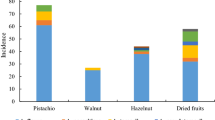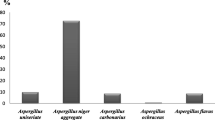Abstract
To investigate contamination of ground red pepper with fungi and mycotoxin, we obtained 30 ground red pepper samples from 15 manufacturers in the main chili-pepper-producing areas in Korea. Fungal contamination was evaluated by spreading diluted samples on potato dextrose agar plates. The total fungi counts ranged from 0 to 7.3 × 103 CFU/g. In the samples, the genus Aspergillus had the highest incidence, while Paecilomyces was isolated most frequently. The next most frequent genera were Rhizopus, Penicillium, Cladosporium, and Alternaria. Within Aspergillus, A. ruber was predominant, followed by A. niger, A. amstelodami, A. ochraceus, A. terreus, A. versicolor, A. flavus, and A. fumigatus. The samples were analyzed for aflatoxins, ochratoxin A, and citrinin by ultra-perfomance liquid chromatography (UPLC) with a fluorescence detector. Ochratoxin A was detected from three samples at 1.03‒2.08 μg/kg, whereas no aflatoxins or citrinin were detected. To test the potential of fungal isolates to produce aflatoxin, we performed a PCR assay that screened for the norB-cypA gene for 64 Aspergillus isolates. As a result, a single 800-bp band was amplified from 10 A. flavus isolates, and one Aspergillus sp. isolate. UPLC analyses confirmed aflatoxin production by nine A. flavus isolates and one Aspergillus sp. isolate, which produced total aflatoxins at 146.88‒909.53 μg/kg. This indicates that continuous monitoring of ground red pepper for toxigenic fungi is necessary to minimize mycotoxin contamination.
Similar content being viewed by others
References
Abarca, M., Bragulat, M., Castella, G., and Cabanes, F. 1994. Ochratoxin A production by strains of Aspergillus niger var. niger. Appl. Environ. Microbiol. 60, 2650–2652.
Amaike, S. and Keller, N.P. 2011. Aspergillus flavus. Annu. Rev. Phytopathol. 49, 107–133.
Aydin, A., Erkan, M.E., Baskaya, R., and Ciftcioglu, G. 2007. Determination of aflatoxin B1 levels in powdered red pepper. Food Control 18, 1015–1018.
Aziz, N.H., Youssef, Y.A., El-Fouly, M.Z., and Moussa, L.A. 1998. Contamination of some common medicinal plant samples and spices by fungi and their mycotoxins. Bot. Bull. Acad. Sin. 39, 279–285.
Bellí, N., Ramos, A., Sanchis, V., and Marin, S. 2004. Incubation time and water activity effects on ochratoxin A production by Aspergillus section Nigri strains isolated from grapes. Lett. Appl. Microbiol. 38, 72–77.
Beuchat, L.R. 1992. Media for detecting and enumerating yeasts and moulds. Int. J. Food Microbiol. 17, 145–158.
Bokhari, F.M. 2007. Spices mycobiota and mycotoxins available in Saudi Arabia and their abilities to inhibit growth of some toxigenic fungi. Mycobiology 35, 47–53.
Bokhari, F., Gherbawy, Y., and Najjar, A. 2009. Detection of the patulin-producing potential of some Paecilomyces variotii strains isolated from the air samples of Jeddah City, Saudi Arabia, using the RAPD-PCR technique. Aerobiologia 25, 49–54.
Dao, H.P., Mathieu, F., and Lebrihi, A. 2005. Two primer pairs to detect OTA producers by PCR method. Int. J. Food Microbiol. 104, 61–67.
Dombrink-Kurtzman, M. and McGovern, A.E. 2007. Species-specific identification of Penicillium linked to patulin contamination. J. Food Prot. 70, 2646–2650.
Ehrlich, K.C., Chang, P.K., Yu, J., and Cotty, P.J. 2004. Aflatoxin biosynthesis cluster gene cypA is required for G aflatoxin formation. Appl. Environ. Microbiol. 70, 6518–6524.
Erdogan, A. 2004. The aflatoxin contamination of some pepper types sold in Turkey. Chemosphere 56, 321–325.
Fazekas, B., Tar, A., and Kovács, M. 2005. Aflatoxin and ochratoxin A content of spices in Hungary. Food Addit. Contam. 22, 856–863.
Geiser, D.M., Dorner, J.W., Horn, B.W., and Taylor, J.W. 2000. The phylogenetics of mycotoxin and sclerotium production in Aspergillus flavus and Aspergillus oryzae. Fungal Genet. Biol. 31, 169–179.
Glass, N.L. and Donaldson, G. 1995. Development of primer sets designed for use with PCR to amplify conserved genes from filamentous ascomycetes. Appl. Environ. Microbiol. 61, 1323–1330.
Hacking, A. and Rosser, W.R. 1981. Patulin production by Paecilomyces species isolated from silage in the United Kingdom. J. Sci. Food. Agric. 32, 620–623.
Hong, S.B., Lee, M., Kim, D.H., Chung, S.H., Shin, H.D., and Samson, R.A. 2013. The proportion of non-aflatoxigenic strains of the Aspergillus flavus/oryzae complex from meju by analyses of the aflatoxin biosynthetic genes. J. Microbiol. 51, 766–772.
Jeong, M.S., Ahn, J.J., Akram, K., Kim, G.R., Im, J.G., and Kwon, J.H. 2013. Microbiological and physicochemical quality characterization of commercial red pepper powders. J. Food Hyg. Safety 28, 1–6.
Jeswal, P. and Kumar, D. 2015. Mycobiota and natural incidence of aflatoxins, ochratoxin A, and citrinin in Indian spices confirmed by LC-MS/MS. Int. J. Microbiol. 2015, 1–8.
Kim, S.H. 2014. World trend of dried red pepper industry. World Agriculture 166, 73–92.
Kim, H.J., Goo, M.S., Park, J.B., Jeon, H.S., Kim, Y.J., Hong, S.I., Oh, S.Y., Jang, H.J., Lee, N.L., Choi, S.Y., et al. 2011. Development of safety management technology for red pepper processing factory based on quantitative risk assessment. Korea Food Research Institute (KFRI), Seongnam, Republic of Korea.
Kim, D.H., Jang, H.S., Kim, Y.M., and Ahn, J.S. 2009. Survey for contamination and study for reduction of ochratoxin A and aflatoxin in red pepper. J. Food Hyg. Safety 24, 299–306.
Ko, H.J., Kim, D., Choi, J., Yoo, Y.J., and Kyung, K.H. 2004. Mycology of red pepper (Capsicum annuum L.) fruits discolored due to mold growth during sun-drying. Food Sci. Biotechnol. 13, 627–631.
Lee, T., Kim, S., Busman, M., Proctor, R.H., Ham, H., Lee, S., Hong, S.K., and Ryu, J.G. 2015. Rapid detection method for fusaric acid-producing species of Fusarium by PCR. Res. Plant Dis. 21, 326–329.
Lee, W., Sa, J.H., Lee, H.H., Shin, I.C., Shin, H.Y., Bae, C.M., Kim, N.S., You, M.J., and Han, K.S. 2013. Safety assessment of aflatoxins, ochratoxin A and fumonisins in Gangwon province foodstuffs. Rep. Inst. Health Environ. 24, 25–38.
Leitao, J., Le Bars, J., and Bailly, J.R. 1989. Production of aflatoxin B1 by Aspergillus ruber THOM and CHURCH. Mycopathologia 108, 135–138.
Mandeel, Q.A. 2005. Fungal contamination of some imported spices. Mycopathologia 159, 291–298.
Park, M.J., Yoon, M.H., Hong, H.G., Joe, T.S., Lee, I.S., Park, J.H., and Ko, H.U. 2007. A study no the conditions of mycotoxin production–Based on the aflatoxin contents and production in food. Rep. Inst. Health Environ. 20, 183–188.
Pfohl-Leszkowicz, A. and Manderville, R.A. 2007. Ochratoxin a: an overview on toxicity and carcinogenicity in animals and humans. Mol. Nutr. Food Res. 51, 61–99.
Pitt, J.I. and Hocking, A.D. 2009. Fungi and food spoilage. Springer, Boston, MA,USA.
Rustom, I.Y.S. 1997. Aflatoxin in food and feed: occurrence, legislation and inactivation by physical methods. Food Chem. 59, 57–67.
Salari, R., Najafi, H., Boroushaki, M., Mortazavi, S., and Fathi Najafi, M. 2012. Assessment of the microbiological quality and mycotoxin contamination of Iranian red pepper spice. J. Agri. Sci. Tech. 14, 1511–1521.
Santos, L., Marin, S., Mateo, E.M., Gil-Serna, J., Valle-Algarra, F.M., Patino, B., and Ramos, A.J. 2011. Mycobiota and co-occurrence of mycotoxins in Capsicum powder. Int. J. Food Microbiol. 151, 270–276.
Vrabcheva, T.M. 2000. Mycotoxins in spices. Vopr. Pitan. 69, 40–43.
White, T.J., Bruns, T., Lee, S., and Taylor, J. 1990. Amplification and direct sequencing of fungal ribosomal RNA genes for phylogenetics. In Innis, M.A., Gelfand, D.H., Sninsky, J.J., and White, T.J. (eds.), PCR Protocols: a guide to methods and applications, pp. 315–322. Academic Press, San Diego, California, USA.
Author information
Authors and Affiliations
Corresponding author
Rights and permissions
About this article
Cite this article
Ham, H., Kim, S., Kim, MH. et al. Mycobiota of ground red pepper and their aflatoxigenic potential. J Microbiol. 54, 832–837 (2016). https://doi.org/10.1007/s12275-016-6480-2
Received:
Revised:
Accepted:
Published:
Issue Date:
DOI: https://doi.org/10.1007/s12275-016-6480-2




